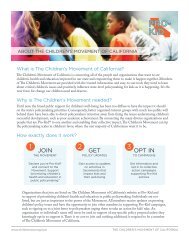Bullying and Violence as Barriers to Academic ... - Children Now
Bullying and Violence as Barriers to Academic ... - Children Now
Bullying and Violence as Barriers to Academic ... - Children Now
Create successful ePaper yourself
Turn your PDF publications into a flip-book with our unique Google optimized e-Paper software.
BEING WELL. LEARNING WELL.<br />
CALIFORNIA HEALTHY STUDENTS<br />
RESEARCH PROJECT<br />
BRIEF NO. 4 IN A SERIES<br />
<strong>Bullying</strong> <strong>and</strong> <strong>Violence</strong> <strong>as</strong><br />
<strong>Barriers</strong> <strong>to</strong> <strong>Academic</strong> Achievement<br />
Jaana Juvonen | University of California, Los Angeles<br />
An alarming 37% of secondary students in California report they experienced some form of har<strong>as</strong>sment or<br />
bullying at school in the p<strong>as</strong>t 12 months. Victims of physical or emotional cruelty feel less safe <strong>and</strong> connected at<br />
school, are more frequently absent, <strong>and</strong> do less well academically than their non-victimized peers. <strong>Bullying</strong> can<br />
account for up <strong>to</strong> an average 1.5 letter grade decre<strong>as</strong>e in an academic subject across the middle school years. Evidence<br />
indicates these compromised academic outcomes are related <strong>to</strong> the emotional distress <strong>and</strong> even somatic<br />
problems that result from being bullied or witnessing it at school. Efforts <strong>to</strong> address this serious problem need <strong>to</strong><br />
focus on two are<strong>as</strong>: 1) educating staff, students, <strong>and</strong> parents about the signs <strong>and</strong> negative effects of bullying, <strong>and</strong><br />
how <strong>to</strong> deal with it; <strong>and</strong> 2) promoting more caring, safe, <strong>and</strong> supportive school environments.<br />
A large percentage of students in California schools<br />
are victims of har<strong>as</strong>sment <strong>and</strong> bullying. The personal<br />
<strong>and</strong> emotional <strong>to</strong>ll that bullying can have on children<br />
h<strong>as</strong> become all-<strong>to</strong>o-apparent — <strong>as</strong> attested <strong>to</strong> by recent<br />
tragedies of youth who see suicide <strong>as</strong> their only way out.<br />
Research also shows that victims of har<strong>as</strong>sment tend <strong>to</strong><br />
have lower grades <strong>and</strong> achievement test scores than their<br />
non–victimized peers, <strong>and</strong> feel generally less safe at, <strong>and</strong><br />
connected <strong>to</strong> school. Greater efforts must be directed <strong>to</strong>ward<br />
reducing school bullying <strong>and</strong> its dev<strong>as</strong>tating effects,<br />
<strong>and</strong> <strong>to</strong>ward creating more positive school climates.<br />
What is the Scope of the Problem in<br />
California<br />
According <strong>to</strong> the California Healthy Kids Survey<br />
(CHKS), in 2005-2007, almost half of students in the<br />
state did not feel very safe in school. One re<strong>as</strong>on for this<br />
is that an average of 37% of secondary students selfreport<br />
experiencing some form of har<strong>as</strong>sment at school<br />
in the p<strong>as</strong>t 12 months. The percentage w<strong>as</strong> the same in<br />
2001-02, indicating that little progress h<strong>as</strong> been made in<br />
reducing har<strong>as</strong>sment in California schools.<br />
It also appears that the percentage of students in California<br />
schools being bullied is greater than in national<br />
estimates. For example, recent national statistics showed<br />
that 28% of 12- <strong>to</strong> 18-year-old students reported having<br />
been bullied at school during the p<strong>as</strong>t six months.<br />
Har<strong>as</strong>sment is highest in California’s middle schools,<br />
where its prevalence is 43% in seventh grade. Although<br />
reports of har<strong>as</strong>sment decline in eleventh grade, it is still<br />
relatively high at 31%. Prevalence rates are even higher<br />
when students are <strong>as</strong>ked if they experienced specific<br />
forms of physical or verbal har<strong>as</strong>sment. Among seventh<br />
graders, 44% report being pushed, shoved, or hit, <strong>and</strong><br />
42%-49% had mean rumors or lies spread about them;<br />
had sexual jokes, comments, or gestures made <strong>to</strong> them;<br />
1
or have been made fun of because of their looks or<br />
speech.<br />
School staff in California perceive that bullying is a<br />
major issue on their campuses. On the California School<br />
Climate Survey (CSCS), 51% of staff in middle schools,<br />
<strong>and</strong> 38% in high schools rated it <strong>as</strong> a moderate-<strong>to</strong>-severe<br />
problem. In middle schools, it is the second-highest perceived<br />
student-related problem after disruptive behavior<br />
(Austin & Bailey, 2008). Both student <strong>and</strong> staff results<br />
underscore the urgent need <strong>to</strong> focus on bullying prevention<br />
efforts in middle schools.<br />
How are Har<strong>as</strong>sment <strong>and</strong><br />
Achievement Related<br />
A recent meta-analysis of 33 studies concluded that<br />
students who are bullied are more likely <strong>to</strong> earn lower<br />
grades <strong>and</strong> scores on st<strong>and</strong>ardized achievement tests<br />
(Nakamo<strong>to</strong> & Schwartz, 2009). This <strong>as</strong>sociation is very<br />
robust across grade levels <strong>and</strong> samples. The few studies<br />
that have examined the causal effects over time indicate<br />
that peer victimization incre<strong>as</strong>es the risk of lower<br />
achievement (e.g., Schwartz et al., 2005). Recent analyses<br />
in California further suggest that bullying can account<br />
for up <strong>to</strong> an average 1.5 letter grade decre<strong>as</strong>e in one<br />
academic subject (e.g., math) across the three years of<br />
middle school (Juvonen, Wang & Espinoza, 2009).<br />
The connection between har<strong>as</strong>sment <strong>and</strong> low academic<br />
achievement h<strong>as</strong> also been observed with schoollevel<br />
data, <strong>as</strong> reported in California Healthy Students<br />
Research Project (CHSRP) Brief No. 1. CHKS data show<br />
that schools with high <strong>Academic</strong> Performance Index<br />
(API) scores had significantly lower rates of har<strong>as</strong>sment<br />
than schools with low API scores, even after adjusting for<br />
socioeconomic <strong>and</strong> other school characteristics. Depending<br />
on the grade level examined, the number of students<br />
reporting rates of har<strong>as</strong>sment w<strong>as</strong> 22-33 percentage<br />
points higher at the schools in the bot<strong>to</strong>m API quintile<br />
than it w<strong>as</strong> at schools in the <strong>to</strong>p API quintile (Hanson,<br />
Austin & Zheng, 2010).<br />
Statistical modeling <strong>and</strong> other research on the<br />
mechanisms that explain this connection indicate that<br />
bullying experiences are related <strong>to</strong> psychological or<br />
behavioral difficulties, which in turn negatively impact<br />
students’ sense of safety <strong>and</strong> connectedness, attendance,<br />
<strong>and</strong> academic achievement. Studies have shown that<br />
emotional distress, somatic problems, depressive symp<strong>to</strong>ms,<br />
<strong>and</strong> poor academic engagement are, in fact, part of<br />
the explanation for the connection between experiencing<br />
har<strong>as</strong>sment <strong>and</strong> academic difficulties. In one study,<br />
emotional problems <strong>as</strong>sociated with being bullied compromised<br />
academic performance <strong>as</strong> early <strong>as</strong> elementary<br />
school (Schwartz et al., 2005).<br />
Consistent with the research summarized above,<br />
California students who have been har<strong>as</strong>sed — compared<br />
<strong>to</strong> their peers who have not — report lower rates<br />
of school safety <strong>and</strong> connectedness, <strong>and</strong> higher rates of<br />
truancy. They are more likely <strong>to</strong> experience a wide range<br />
of psychosocial, behavioral, <strong>and</strong> emotional problems,<br />
such <strong>as</strong> incapacitating sadness or hopelessness, that are<br />
barriers <strong>to</strong> learning (CHKS Factsheets 4 <strong>and</strong> 10).<br />
Who Are the Victims<br />
If we are <strong>to</strong> effectively counter this serious problem,<br />
we must take in<strong>to</strong> account the fac<strong>to</strong>rs that research h<strong>as</strong><br />
shown <strong>to</strong> incre<strong>as</strong>e or decre<strong>as</strong>e the risk of bullying <strong>and</strong> its<br />
negative emotional effects. Although certain individual<br />
personality characteristics place students at risk, there<br />
are also groups who are more vulnerable than others.<br />
Students generally considered <strong>to</strong> be “different” from their<br />
peers are likely <strong>to</strong> be the targets. For example:<br />
• Youth who are not socially integrated are more<br />
vulnerable <strong>to</strong> har<strong>as</strong>sment. Students with at le<strong>as</strong>t<br />
one friend at school are less likely <strong>to</strong> be bullied<br />
<strong>and</strong> are also better protected from the negative<br />
emotional effects of har<strong>as</strong>sment.<br />
• Students who are har<strong>as</strong>sed because of sexual orientation<br />
or disability experience particularly high<br />
rates of academic, health, social, <strong>and</strong> personal<br />
problems (CHKS Factsheets 4 <strong>and</strong> 10).<br />
• Ethnic minority youth also appear <strong>to</strong> be at higher<br />
risk for har<strong>as</strong>sment (see CHKS Factsheet 9),<br />
although their relative representation within a<br />
school appears <strong>to</strong> affect this risk, <strong>as</strong> discussed<br />
below.<br />
Interestingly, the social st<strong>and</strong>ing of learning-disabled<br />
students in inclusive settings appears <strong>to</strong> be improved<br />
when roughly one-third of the students in a cl<strong>as</strong>sroom<br />
had mild learning disabilities. This finding suggests that<br />
having a critical m<strong>as</strong>s of students who differ from most<br />
2
others may help protect them from har<strong>as</strong>sment <strong>and</strong> bullying.<br />
The witnesses of bullying are also among its victims.<br />
Levels of social anxiety are elevated not only among<br />
those who are bullied, but also among students who see<br />
someone else being bullied. This helps explain the negative<br />
effects of bullying at the school level.<br />
How Do School Characteristics<br />
Influence Har<strong>as</strong>sment<br />
Some school environments are riskier than others.<br />
Most notably, studies have found:<br />
• Small schools tend <strong>to</strong> have fewer problems with<br />
bullying than larger schools. This may be due in<br />
part <strong>to</strong> inadequate moni<strong>to</strong>ring at larger schools,<br />
<strong>as</strong> bullying most frequently occurs in unmoni<strong>to</strong>red<br />
are<strong>as</strong> of schools (e.g., restrooms, locker<br />
rooms, <strong>and</strong> hallways).<br />
• Schools where rules are perceived <strong>to</strong> be fair <strong>and</strong><br />
where there are generally fewer disciplinary problems<br />
have lower rates of bullying.<br />
• Greater parent involvement h<strong>as</strong> been related <strong>to</strong><br />
lower rates of bullying.<br />
• Caring environments reduce risk. CHKS data<br />
show that students — including those who experience<br />
har<strong>as</strong>sment — with high levels of caring<br />
adult role models are more likely <strong>to</strong> perceive their<br />
schools <strong>as</strong> safe, <strong>and</strong> <strong>to</strong> report school connectedness.<br />
They are less likely <strong>to</strong> be truant, have poor<br />
grades, or show poor mental health indica<strong>to</strong>rs.<br />
This supports research findings reported in<br />
CHSRP Brief No. 6 on personalization, indicating<br />
that caring adult relationships act <strong>as</strong> a protective<br />
fac<strong>to</strong>r.<br />
• Greater ethnic diversity h<strong>as</strong> been <strong>as</strong>sociated with<br />
reduced self-reports of bullying <strong>and</strong> higher perceptions<br />
of school safety for African American<br />
<strong>and</strong> Latino students in California middle schools<br />
(Juvonen, Nishina & Graham 2006). This is<br />
consistent with the research reported above that<br />
showed having a critical m<strong>as</strong>s of students who<br />
might be regarded <strong>as</strong> “different” operated <strong>as</strong> a<br />
protective fac<strong>to</strong>r.<br />
What Can We Do<br />
There are no simple or quick fixes <strong>to</strong> bullying. It is<br />
not enough <strong>to</strong> write anti-bullying policies or <strong>to</strong> designate<br />
one school staff member <strong>to</strong> deal with bullying issues.<br />
Although school-size reduction might help, this is not<br />
fe<strong>as</strong>ible in the current economic environment. However,<br />
research h<strong>as</strong> supported the value of implementing a constellation<br />
of components <strong>to</strong> improve the social climate<br />
of schools <strong>and</strong> protect all students, including high-risk<br />
populations. Attention in particular must be addressed<br />
<strong>to</strong>ward two are<strong>as</strong> — training <strong>and</strong> strengthening relationships.<br />
• Training. Schools need <strong>to</strong> proactively take action<br />
<strong>to</strong> create more caring, safe, <strong>and</strong> supportive school<br />
environments involving students <strong>and</strong> adults.<br />
At le<strong>as</strong>t one positive relationship with a caring<br />
adult at the school needs <strong>to</strong> be fostered that also<br />
provides a “safe place” for students. Caring peer<br />
relationships are particularly important (e.g.,<br />
through a buddy program) when students transfer<br />
<strong>to</strong> a new school during off-times.<br />
• Strengthening Relationships. Staff, students, <strong>and</strong><br />
parents need <strong>to</strong> be educated about the signs of<br />
bullying, its negative effects on emotional wellbeing<br />
<strong>and</strong> academic achievement, <strong>and</strong> how <strong>to</strong><br />
deal with it, including establishing <strong>and</strong> consistently<br />
following anti-bullying policies.<br />
The most comprehensive, evidence-b<strong>as</strong>ed, school<br />
anti-bullying programs are b<strong>as</strong>ed on the Bully/Victim<br />
Program, designed originally by Dan Olweus in Norway<br />
(Olweus, 1993). They aim <strong>to</strong> change the school culture<br />
in<strong>to</strong> a caring climate where everyone feels safe, <strong>and</strong> the<br />
victims of bullying are supported by peers <strong>and</strong> adults<br />
alike. The main goal is <strong>to</strong> restructure the social environment<br />
such that there are fewer opportunities <strong>and</strong> rewards<br />
for any kinds of hostile <strong>and</strong> intimidating behaviors.<br />
3
References<br />
Austin, G., & Bailey, J. (2008). What teachers <strong>and</strong> other staff<br />
tell us about California schools: Results of the California<br />
School Climate Survey, 2004-2006. San Francisco: WestEd.<br />
California Healthy Kids Survey Factsheets <strong>and</strong> data on<br />
har<strong>as</strong>sment may be downloaded from chks.wested.org/using_results/publications.<br />
Hanson, T., Austin, G., & Zheng, H. (2010). <strong>Academic</strong><br />
performance <strong>and</strong> school well-being in California. California<br />
Healthy Students Research Project Research Brief. No. 1.<br />
San Francisco: WestEd.<br />
Juvonen, J. & Graham, S. (2004). Research b<strong>as</strong>ed interventions<br />
on bullying. In S. E. S<strong>and</strong>ers & G. D. Phye (Eds.), <strong>Bullying</strong>,<br />
implications for the cl<strong>as</strong>sroom: What does the research<br />
say (pp.229-255) <strong>Academic</strong> Press.<br />
Juvonen, J., Nishina, A., & Graham, S. (2006). Ethnic diversity<br />
<strong>and</strong> perceptions of safety in urban middle schools.<br />
Psychological Science, 17, 393-400.<br />
Juvonen, J., Wang, Y., & Espinoza, G. (2009). Do peer victimization<br />
experiences compromise academic performance across<br />
middle school grades Paper under review.<br />
Nakamo<strong>to</strong>, J. & Schwartz, D. (2009). Is peer victimization<br />
<strong>as</strong>sociated with academic achievement A meta-analytic<br />
review. Social Development, 19, 221-242.<br />
Olweus, D. (1993). <strong>Bullying</strong> at School: What We Know <strong>and</strong><br />
What Can We Do. Oxford, Enl<strong>and</strong>: Blackwell.<br />
Schwartz, D. Gorman, A. H., Nakamo<strong>to</strong>, J. & Toblin, R.<br />
L. (2005). Victimization in the peer group <strong>and</strong> children’s<br />
academic functioning. Journal of Educational Psychology,<br />
97, 425-435.<br />
BEING<br />
WELL.<br />
LEARNING<br />
WELL.<br />
The California Healthy<br />
Students Research Project<br />
is devoted <strong>to</strong> underst<strong>and</strong>ing<br />
<strong>and</strong> addressing issues of health<br />
<strong>and</strong> well-being that hurt student<br />
achievement. By researching health<br />
<strong>and</strong> education issues in the state,<br />
the project provides evidence-b<strong>as</strong>ed<br />
policy <strong>and</strong> practice recommendations<br />
<strong>to</strong> foster the school culture, environment, supports <strong>and</strong><br />
services needed <strong>to</strong> give all youth the opportunity <strong>to</strong> be<br />
successful learners.<br />
The project w<strong>as</strong> conducted by WestEd <strong>and</strong> the Philip R. Lee<br />
Institute for Health Policy Studies, University of California<br />
San Francisco. It w<strong>as</strong> funded by The James Irvine Foundation,<br />
The California Endowment <strong>and</strong> The William <strong>and</strong> Flora Hewlett<br />
Foundation <strong>and</strong> guided by an advisory committee made up of<br />
dozens of leaders within California’s health <strong>and</strong> education sec<strong>to</strong>rs.<br />
Find complete research reports at LearningWellBeingWell.org<br />
Project direc<strong>to</strong>rs:<br />
Gregory Austin, Ph.D.<br />
gaustin@wested.org<br />
Claire Brindis, Dr. P.H.<br />
claire.brindis@ucsf.edu<br />
4






